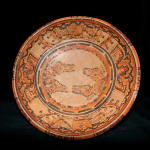Mayan Polychrome Plate with Four Rattle Feet, 600 CE - 900 CE
Terracotta
PF.2927
The exuberantly painted design and cleverly displayed vulture head “feet” undoubtedly remind us reminded that the Late Classic Period saw the intensification of Maya elite culture through the Southern Lowlands....
The exuberantly painted design and cleverly displayed vulture head “feet” undoubtedly remind us reminded that the Late Classic Period saw the intensification of Maya elite culture through the Southern Lowlands. Hundreds of cities, large and small, were ruled by lineages that warred with one another, oversaw the construction of extraordinary buildings, recorded their histories in stone and commissioned artisans to create majestic pottery such as our eyes now behold. In the center of the plate, baby vultures are hatching forth from their eggs and full-grown vulture heads are used for the rattle "feet." In Classic inscriptions, the vulture was used to write the title ahau or "lord." When a vulture head was used as ahua, it always appeared with the headband crown of Maya kings to ensure that the vulture was read with the meaning ahau, "lord." The vulture head rattle "feet" on this important regal plate clearly represent the headband crown of Maya kings that was drawn in the ancient Classic inscriptions. Perhaps the hatching vulture eggs in the center portray the birth of a baby who has just been born into the royal Maya kingship. The plate itself may have been used in ritual to honor the newborn lord and to commemorate his title. Important members of ruling lineages were called ahau, "lord," but only the king bore the title of mah k'na, "great sun." As we turn the plate past the delightful emergence of a turtle's head and feet to view the underside, we wonder if the vibrant yellow sun reveals to us this baby's predetermined destiny to be the future ruling mah k'ina, the greatest honor of all.



